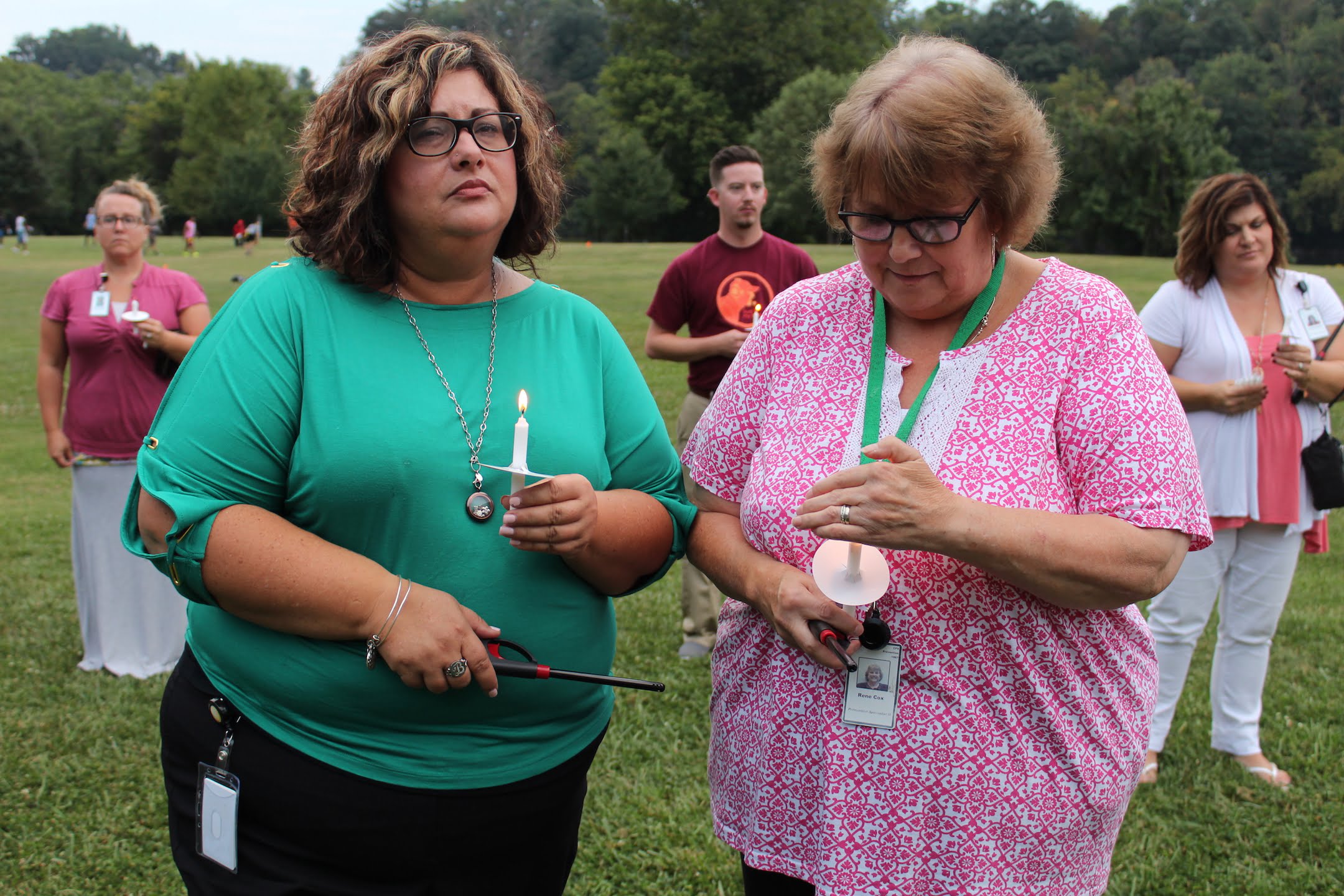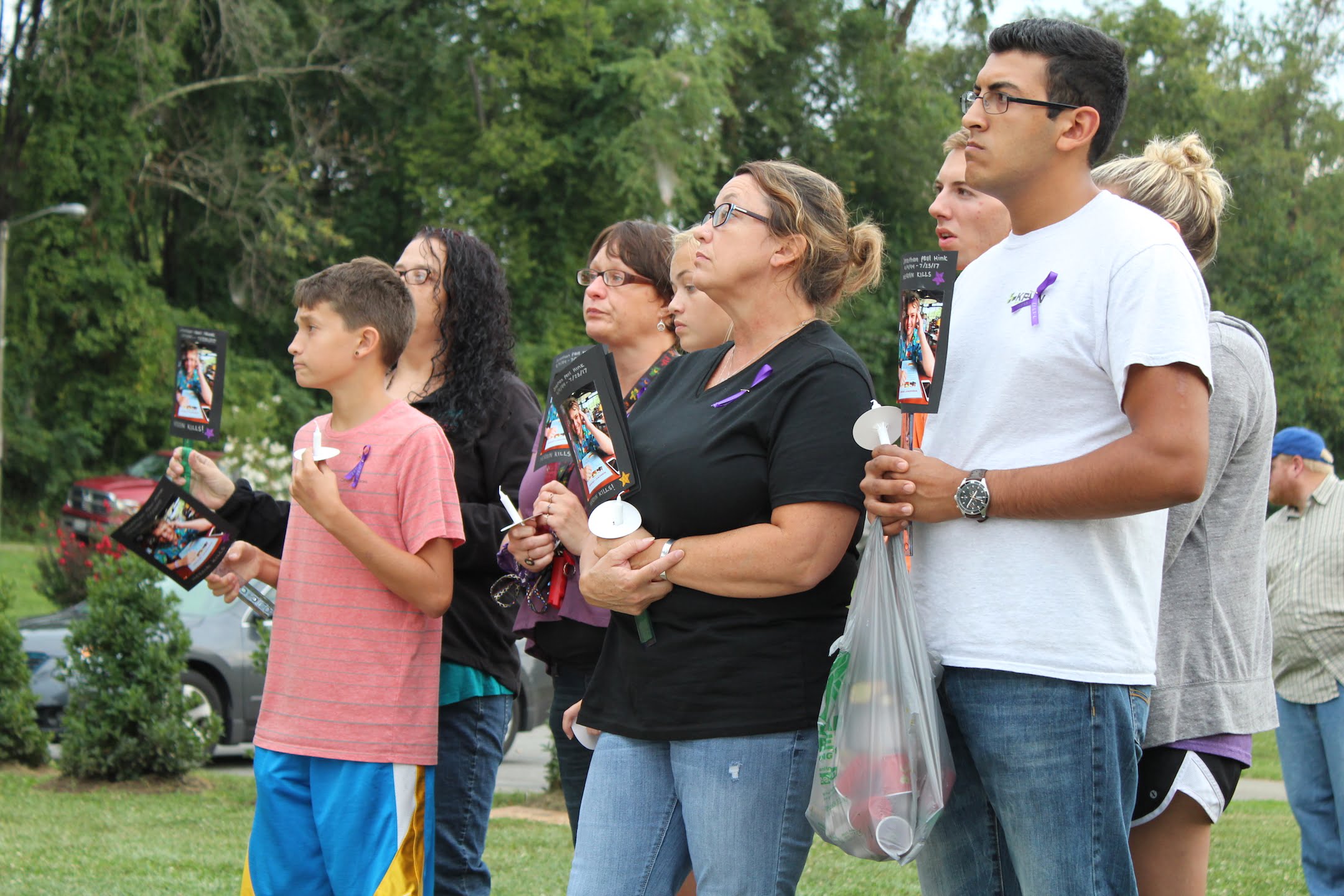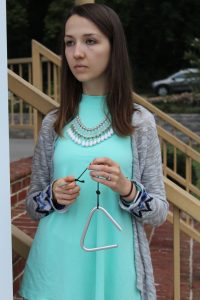
Rhonda Dean (left) and Rene Cox light candles during Thursday’s special event at Bisset Park to bring awareness to the rising opioid overdose problem.
Every 12 minutes someone dies from an opioid overdose was the underlying message of a candlelight event Thursday at Bisset Park in Radford. Addiction became a reality as part of the observance of International Overdose Awareness Day event hosted by New River Valley Community Services.
Speakers included area health professionals and individuals that personally been affected by addiction and overdose deaths directly connected to opioids.
New River Health District Director Noelle Bissell, M.D. pointed out that estimates show 20-30 million people nationwide are addicted to drugs and/or alcohol. “And that is probably conservative,” she said, with only 10 million getting treatment.
“Most people don’t choose to become addicted to narcotics. There is no one face to addiction, but there is a huge negative stereotype. Someone standing next to you, your neighbor, a co-worker or friend, or a family member could be one of the many faces. Addiction knows no racial, cultural, gender or socioeconomic boundaries,” she said.
Opioids are an umbrella term for synthetic drugs that are derived from or related to the opium poppy. Commonly known opioids include oxycodone, morphine, codeine, heroin, fentanyl, methadone and opium.
Medical experts say opioids dull the senses and induce a sense of relaxation and euphoria, thus causing the user to become addicted.

“There is a lot of blame going around for the current opioid epidemic,” said Bissell. “The pharmaceutical industry marketed opioids as a cure-all for pain with little risk of addiction. The government brought that message and made pain the fifth vital sign; physicians overprescribed; and patients expected complete relief and a fix to all al of the problems—a pill for every ill.”
The numbers are staggering as the for the past two years overdoses have taken more lives than motor vehicle accidents or firearms nationally. Between 2000-2015, there were 500,000 overdose deaths in the U.S., and recent statistics showing 91 deaths per day.
In Virginia, those same numbers show that overdoses killed 1,133 individuals in 2016. That was a 30 percent increase, according to the NRV Health District, from 2015 and double from 2010. In addition, car crashes involving substance abuse are up 700 percent.
Virginia emergency departments reported more than 10,000 visits for opioid and heroin overdose treatment, and EMS workers reported more than 4,000 uses of naloxone, an overdose-reversal drug.
But Bissell was quick to point out the epidemic is more than the numbers and statistics. “It’s the people—the lives lost, the families shattered, the children who lose their parents—we need to bring those faces back into focus as we tackle it. We will never totally eliminate substance use, but we need to get it back into reasonable control,” she said.
That message could be seen in the faces of a lot of the people which attended Thursday’s event include several who stepped to the microphone and told their story of struggle or that of a close friend or relative.
Kim Curtis is a counselor with the NRV Community Services Board and knows addiction and its battle first-hand. She, too, is a recovering addict and told her story to onlookers Thursday night.
“Every year, we lose thousands of people from drug overdose. Some may survive while others may suffer a permanent injury with devastating impacts to their families,” she said.
Neither Radford nor the New River Valley is immune to this problem, Curtis said, and people need to realize this problem is here in our own backyard.
“It has happened to people around you. Tomorrow, it could happen to someone you love. It happened to me,” she said.
“I never set out to become addicted to drugs. Something as innocent as a dental procedure began the love affair.”
Curtis hopes her message of addiction and now her road of recovery will help others to deal with the problem. “Tonight, I declare recovery is possible,” she said.
Kenneth Meadows Jr. of Pulaski spoke about his twin sister who died in 2009 after losing her battle with a drug addiction. His sister’s problem drastically affected everyone her, but he admitted her struggle has made him value his own life and open to bringing awareness to the problem.

“Others,” he said, “need to hear his story—his sister’s story—and maybe gain help.”
“I’m not alone. You’re not alone. We’re all in this fight together,” Meadows said.
Standing nearby was the family of Jonathan Paul Hink, a 23-year-old Radford University graduate who passed away last month after a heroin overdose. His sister is currently a sophomore at RU, and several family members still live in Blacksburg. The family hopes his story will help others struggling with a similar addiction.
His mother, Karla Hink, said her son had a good life but was addicted to heroin and struggled with it up until his death.
As dusk fell on the park, a crowd of nearly a hundred people lit candles to remember those that have been lost through addiction and those still fighting the tough battle.
The New River Valley Community Services Board hopes to hold more events like Thursday’s in the near future to increase attention to the problem and how our community can deal with it.
The NRV Community Services Board is one of 18 public agencies in the state of Virginia to recently receive a $9.76 million federal grant to help fight the opioid epidemic.
The one-year grant comes from the Substance Abuse and Mental Health Services Administration, an agency of the U.S. Department of Health and Human Services. It will support prevention, treatment and recovery efforts, and will be administered by the Department of Behavioral Health and Developmental Services.


